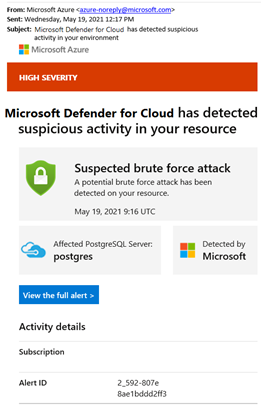Events
May 19, 6 PM - May 23, 12 AM
Calling all developers, creators, and AI innovators to join us in Seattle @Microsoft Build May 19-22.
Register todayThis browser is no longer supported.
Upgrade to Microsoft Edge to take advantage of the latest features, security updates, and technical support.
Microsoft Defender for Cloud detects anomalous activities indicating unusual and potentially harmful attempts to access or exploit databases for the following services:
and for RDS instances on AWS (Preview):
To get alerts from the Microsoft Defender plan you'll first need to enable Defender for open-source relational databases on your Azure or AWS account.
Learn more about this Microsoft Defender plan in Overview of Microsoft Defender for open-source relational databases.
You need a Microsoft Azure subscription. If you don't have an Azure subscription, you can sign up for a free subscription.
You must enable Microsoft Defender for Cloud on your Azure subscription.
AWS users only - Connect your AWS account.
When Microsoft Defender for Cloud is enabled on your database, it detects anomalous activities and generates alerts. These alerts are available from multiple locations, including:
In the Azure portal:
In the inbox of whoever in your organization has been designated to receive email alerts.
Tip
A live tile on Microsoft Defender for Cloud's overview dashboard tracks the status of active threats to all your resources including databases. Select the security alerts tile to go to the Defender for Cloud security alerts page and get an overview of active threats detected on your databases.
For detailed steps and the recommended method to respond to security alerts, see Respond to a security alert.
Defender for Cloud sends email notifications when it detects anomalous database activities. The email includes details of the suspicious security event such as the nature of the anomalous activities, database name, server name, application name, and event time. The email also provides information on possible causes and recommended actions to investigate and mitigate any potential threats to the database.
From the email, select the View the full alert link to launch the Azure portal and show the security alerts page, which provides an overview of active threats detected on the database.

View active threats at the subscription level from within the Defender for Cloud portal pages:
For additional details and recommended actions for investigating the current threat and remediating future threats, select a specific alert.
Tip
For a detailed tutorial on how to handle your alerts, see Manage and respond to alerts.
Events
May 19, 6 PM - May 23, 12 AM
Calling all developers, creators, and AI innovators to join us in Seattle @Microsoft Build May 19-22.
Register today